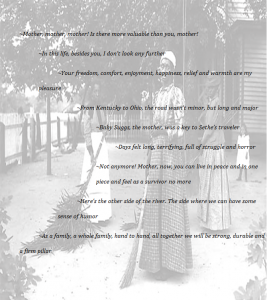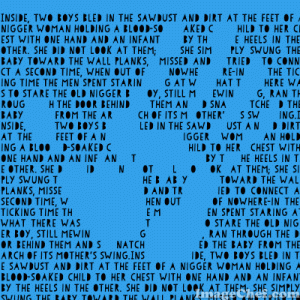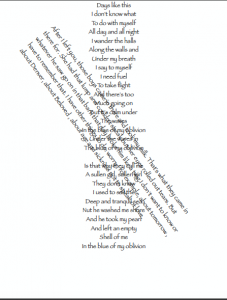In the story “Beloved,” by Toni Morrison, there are many outstanding moments that are important to the information the author wished to convey. However, the most pivotal moment in the novel is the killing of Sethe’s first daughter. Had this moment not occurred the main idea of the plot could not be developed. Also, the title would most likely be different. This is because the title “Beloved,” is the name the dead baby acquired after her reincarnation.
As the story progressed readers know and understand the dead baby is Sethe’s child but are not readily given information as to how the baby died. On page 92 of my reading the narrator gave an indication of the events that led to the killing of the baby as stated by Sethe, when she tried to give her boyfriend, Paul D, what she thought was a logical explanation for killing her baby. The narrator stated, “simple: she was squatting in the garden and when she saw them coming and recognized Schoolteacher’s hat, she heard wings. Little hummingbirds stuck there needle beaks right through her head cloth into her hair and beat their wings. And if she thought anything, it was No. No. Nonono. Simple. she just flew Collected every bit of life she had made, all the parts of her that were precious and fine and beautiful, and carried, pushed, dragged them through the veil, out, away, over there where no one could hurt them. ….By the time she faced him [Schoolteacher], looked him dead in the eye, she had something in her arms that stopped him in his tracks. He took a backward step with each jump of the baby heart until finally there was none.”
It was accidentally that Sethe happen to see Schoolteacher before he saw her. Because she was sitting or bending down in the garden she was able to see his hat floating above the fence as he approached the house. Bells went off in her head she did not need a visual of his body. She could never mistake the man who had beat her so badly before she escaped. She knew his presence meant only one thing, a return to slavery for her and her children. In a frenzy and on impulse she grabbed what was dear to her, her children and somehow managed to get them all to the woodshed. Once there she decided to do whatever it took to keep them safe. In her mind they would all be better off dead, than alive as slaves. Schoolteacher was shocked when he saw her holding the baby, he moved away from her when he noticed what Sethe had done to her own. As he moved backwards the baby’s life slipped away with every step until Sethe felt the last heartbeat of her daughter.
The killing of the baby set a series of events in motion that formed the plot of the story. Sethe had experienced slavery in some of the worst ways. She knew what was waiting for her if she allowed Schoolteacher to take them back. She knew what it was like to be beaten, classified as an animal and having reservations about loving anything, even her children, because they could be taken away and sold as her master wished. Because she knew all these things as soon as she recognized that hat she sprang into action. She kept saying no repeatedly because after escaping slavery and experiencing the joys of freedom and allowing herself to love her children, psychologically she could not visualize herself and her children living as slaves again. She moved very fast, like a hummingbird, that was how quickly she gathered all her children. They were the only thing that mattered to her in life. Somehow on her own she was able to carry, push, pull and drag her children to the woodshed. On impulse she decided death would be a better option, death would be safer. She tried but succeeded in killing only her first daughter. This is the daughter that after her death set off a series of events that changed the life of Sethe and her family. She took to haunting the house and later reincarnated in the flesh and using the only word Sethe could afford to have inscribed on her headstone as he name, “Beloved.”
Paul D arrived at the house at Bluestone Road and was happy to see Sethe again. He became content there and decided to stay with Sethe. He successfully got rid of the baby ghost and life at the house seemed to be back to normal for Sethe and Denver. Things began to gradually change for the worst after Beloved appeared out of nowhere. Her presence caused problems in Sethe’s relationship with Paul D. Others began to wonder what was going on at the house and who the new arrival was. Stamp Paid was no exception, he was the man who helped Sethe escaped slavery. He was not content with Sethe’s boyfriend Paul D living at Bluestone Road without knowing her brutal past. He took it upon himself to inform Paul D of the unfortunate events that occurred years before at that house, in the wood shed. It was a newspaper clipping with her picture that Stamp Paid used as evidence when he confronted Paul D. Paul D was shocked by the news and was in denial. In an effort to further elaborate on the unfortunate events that day the narrator explained Stamp Paid thoughts on page 89 of my reading `by stating, “Stamp Paid looked at him….He was going to tell him that, because he thought it was important: why he and Baby Suggs both missed it. And about the party too, because that explained why nobody ran on ahead, why nobody sent a fleet footed son to cut ‘cross a field soon as they saw the four horses in town hitched for watering while the riders asked questions. Not Ella, not John, not anybody ran down to Bluestone Road, to say some new white folk with the look just rode in. The righteous look every Negro learned to recognize along with his ma’am tit. Like a flag hoisted, this righteousness telegraphed and announce the faggots the whip, the fist, the lie long before it went public.”
Stamp Paid felt compelled to explain to the shocked Paul D why nothing was done to prevent Sethe from reaching her breaking point that day. He felt he had to let Paul D understand that he and Baby Suggs had a feeling something was wrong but did not pinpoint what it was until too late. He wanted to offer an explanation about why no one in town sent a warning to Bluestone Road. No one sent one of their sons who ran fast to take a shortcut to the house with a warning. He wanted to tell him Baby Suggs had given a big party the day before and exhaustion could have contributed to the inattention the town gave the new arrivals. After all, it was a time in slavery when strangers who rode into town stood out and everyone heard of their arrival quickly. Strange white men who had a certain way of carrying themselves were viewed with more suspicion than usual.
As shocked as Paul D was about Sethe snatching up her children and taking them to the wood shed where she succeeded in killing one and attempted to kill the others, Stamp Paid felt deep down, just by the look on Paul D’s face that he was also shocked that no one warned Sethe and the other occupants at Bluestone Road that these men were coming. The author elaborated that not Ella or John made an effort to send a warning because we have come to know Ella and John as being absolutely against slavery and did everything they could to protect Negroes. They made it their duty to know what was going on so they could help in any way they could. On that particular day they failed Sethe’s family, the same family they so valiantly helped to escape slavery. Stamp Paid felt he was obligated to offer an explanation as to why Ella, John and the rest of the town did not warn the family. He wanted to make him understand that although the men had the look that indicated they were slave catchers asking questions to track down escaped slaves in order to recapture and probably beat, torture and quote passages from for the bible to support the need of Negroes to remain in slavery, no one came with a warning, no one helped Sethe that day to hide herself and her children before it was too late.
The quotation mentioned above is important to what is considered the most pivotal moment in the novel. This is the moment where the arrival of the slave catchers led to Sethe killing her baby. This baby was killed violently. The author revealed later that Sethe used a handsaw to cut her throat. It was angry baby who after haunting Sethe and her family for years returned as Beloved, who professed outwards, love for Sethe but was plotting to harm her in revenge for the suffering she experienced. Beloved is the character that drives the main plot of the story. Without her initial death this would not be possible. Therefore, the quote in paragraph one is indeed the pivotal moment in the novel.
Paul D was unforgiving of Sethe’s killing her child. On page 93 of my reading he stated, “What you did was wrong Sethe….You have two feet, Sethe, not four.” And the narrator went on to say that, “right then and there a forest sprang up between them, trackless and quiet.” Upon realizing the news Stamp Paid told him was true Paul D could not support the decision Sethe had made and he told her exactly how he felt. To him it was the wrong decision.
He tried to explain to her that as a human being she had made the wrong choice. He tried to make her see that her way seemed animalistic. He made it clear that nothing she said would make him believe killing was the best way to keep her children safe. After they had that conversation their relationship ended. It was as if Paul saw her as a monster or an animal, she was no longer the woman he had always admired and loved. He could no longer continue their relationship and the distance was evident to both of them even before the conversation ended.






